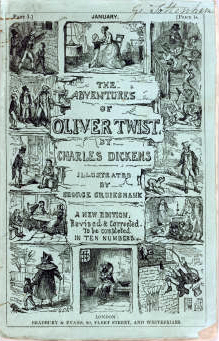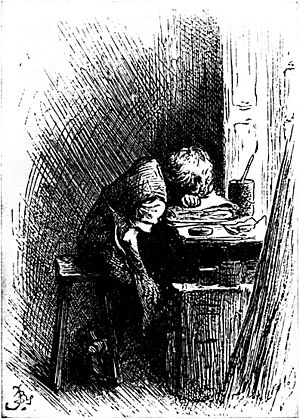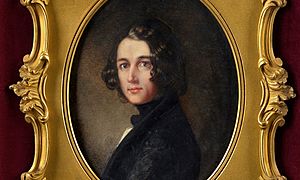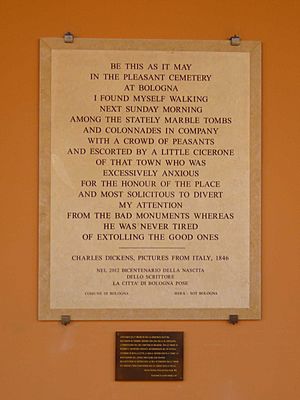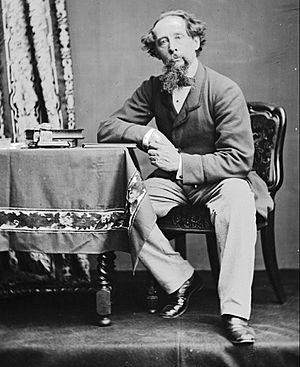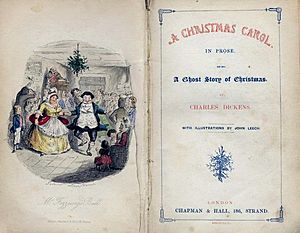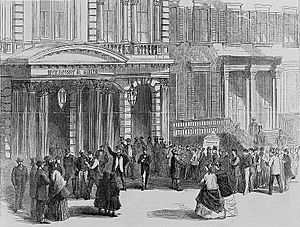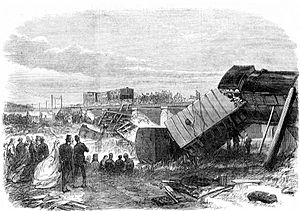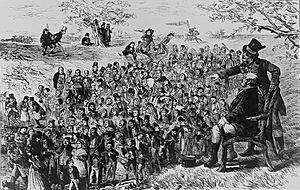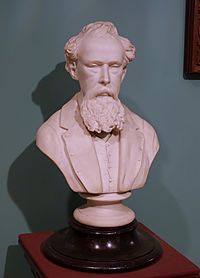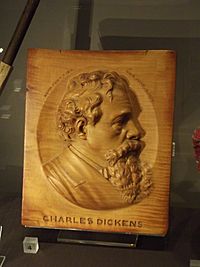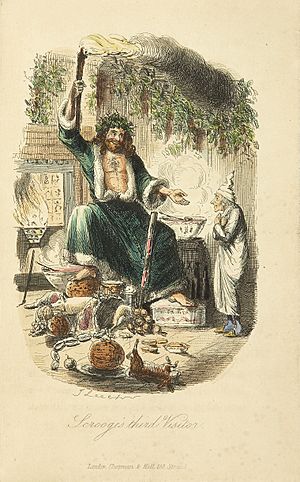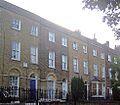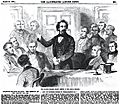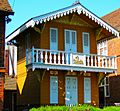Charles Dickens facts for kids
Quick facts for kids
Charles Dickens
|
|
|---|---|
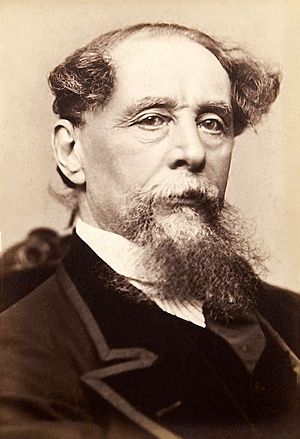 |
|
| Born | Charles John Huffam Dickens February 7, 1812 Landport, Portsmouth, England |
| Died | June 9, 1870 (aged 58) Gad's Hill Place, Higham, Kent, England |
| Resting place | Poet's Corner, Westminster Abbey |
| Occupation | Novelist |
| Notable works | Sketches by Boz, The Old Curiosity Shop, Oliver Twist, Nicholas Nickleby, Barnaby Rudge, A Christmas Carol, Martin Chuzzlewit, A Tale of Two Cities, David Copperfield, Great Expectations, Bleak House, Little Dorrit, Hard Times, Our Mutual Friend, The Pickwick Papers |
| Signature | |
 |
|
Charles John Huffam Dickens (February 7, 1812 – June 9, 1870) was a famous English writer. He is known for creating some of the world's most popular characters. Many people think he was the greatest novelist of the Victorian era. His books were very popular when he was alive. Today, his novels and short stories are still read by many people. Some of his most famous works include A Christmas Carol, Oliver Twist, Great Expectations, and A Tale of Two Cities.
Even though he did not go to school for a long time, he wrote many different kinds of works. He wrote 15 novels, five shorter novels called novellas, and hundreds of short stories. He also wrote many non-fiction articles. Dickens gave many talks and readings of his works. He wrote many letters and edited a weekly magazine for 20 years. He also worked hard to improve children's rights and education.
Many other writers, like Leo Tolstoy and George Orwell, admired Dickens. They praised his realistic writing, his humor, and his unique characters. He was also known for his social criticism. The word Dickensian is now used to describe things. It often means poor social conditions or funny, unpleasant characters, like those in his books.
Contents
- Early Life of Charles Dickens
- Becoming a Famous Writer
- Travels to America
- Back in England
- Second Visit to the United States
- Last Years and Death
- Famous Characters
- Marriage and Family
- Charles Dickens's Legacy
- Famous Quotes by Charles Dickens
- Interesting Facts About Charles Dickens
- Books by Charles Dickens
- Images for kids
- See also
Early Life of Charles Dickens
Charles Dickens was born in Portsmouth, England. His parents were John Dickens, who worked for the navy, and Elizabeth Barrow.
When Charles was ten, his family moved to London. His father was sent to prison because he owed money. Charles had to work in a factory that made shoe polish. These difficult times gave him ideas for many of his novels. When his grandmother died, his father's debts were paid, and he left prison. Charles then finished school. He got a job as an office boy for a lawyer. He found this job boring. So, he taught himself shorthand and became a journalist. He reported on the government.
Becoming a Famous Writer
In 1832, when he was 20, Dickens wanted to be famous. He just wasn't sure how. In 1833, he sent his first story, "A Dinner at Poplar Walk," to a London magazine. He worked as a political journalist. He reported on debates in Parliament. He also traveled across Britain to write for a newspaper called the Morning Chronicle.
In 1835, the Morning Chronicle started an evening newspaper. They hired George Hogarth to be the editor. Hogarth invited Dickens to write short pieces called Street Sketches. Dickens often visited Hogarth's home. He enjoyed spending time with Hogarth's three daughters. One of them was nineteen-year-old Catherine, who he later married.
Dickens's Sketches by Boz caught the eye of some publishers. They asked him to write stories to go with pictures in a monthly magazine. In 1836, these stories became The Pickwick Papers. The first few parts were not very popular. But the story became famous after a character named Sam Weller was added. In just a few years, Dickens became famous beyond England. People knew him for his humor, his clever observations, and his comments on society.
In November 1836, Charles became the editor of Bentley's Miscellany. He held this job for three years. As he finished The Pickwick Papers, he started writing Oliver Twist. He wrote about 90 pages a month. He also continued working on Bentley's. During this time, he wrote four plays and helped produce them. Oliver Twist, published in 1838, became one of his best-known stories. It was the first Victorian novel with a child as the main character.
His books were often published in monthly or weekly parts. This way of publishing stories in installments became very popular in England. Readers eagerly waited for each new part. Even the young Queen Victoria read Oliver Twist and Pickwick. She stayed up late to talk about them. Other popular novels followed, like Nicholas Nickleby (1838–39) and The Old Curiosity Shop (1840–41). His first historical novel, Barnaby Rudge, was also published in parts.
Travels to America
In 1842, Charles and his wife Catherine made their first trip to the United States and Canada. Catherine's sister, Georgina Hogarth, joined the Dickens household. She helped care for their young children while Charles and Catherine were away. Georgina stayed with them as a housekeeper and friend until Dickens died in 1870.
Charles wrote about his trip in a travel book called American Notes for General Circulation. In this book, Dickens spoke out against slavery. He had also done this in The Pickwick Papers. He made a lot of money from his trip, but he did not enjoy it very much. During his travels, Dickens visited many northeastern states and Canada. He gave talks and performed in stage comedies.
Back in England
Soon after returning to England, Dickens started writing his famous Christmas stories. The first was A Christmas Carol, written in 1843. He wrote two more Christmas books, The Chimes in 1844 and The Cricket on the Hearth in 1845. But A Christmas Carol became his most famous. It helped make Christmas celebrations more popular in Britain and America.
Dickens lived in Italy for a short time in 1844. He also traveled to Switzerland. There, he began writing more serious and carefully planned works. These included Dombey and Son and David Copperfield.
In 1862, Charles was offered a large sum of money to do a reading tour in Australia. He was excited, but he decided not to go. However, two of his sons, Alfred D'Orsay Tennyson Dickens and Edward Bulwer Lytton Dickens, did move to Australia. Edward later became a member of the Parliament of New South Wales.
Second Visit to the United States
Charles wanted to return to the United States sooner. But the American Civil War in 1861 delayed his plans. Dickens arrived in America on November 9, 1867. He spent the rest of the month going to fancy dinner parties. He met famous people like Ralph Waldo Emerson and Henry Wadsworth Longfellow.
In early December, Dickens began his reading tour. He gave 76 readings and earned a lot of money. This was from December 1867 to April 1868. Charles traveled between Boston and New York. In New York, he gave 22 readings at Steinway Hall. He was very busy, even though he was not feeling well. He even found time to go sleighing in Central Park.
During his travels, Dickens noticed changes in America. At his last American event, a banquet held by the American Press, he publicly apologized. He said he was sorry for speaking negatively about America before. On April 23, he sailed back to Britain.
Last Years and Death
On May 2, Dickens made his last public appearance. It was at a banquet for the Royal Academy of Arts. The Prince and Princess of Wales were there. He gave a special speech about his friend, the illustrator Daniel Maclise, who had died.
On June 9, 1865, Charles was in a serious Staplehurst rail crash while returning from Paris. The train's first seven cars fell off a bridge that was being fixed. The only first-class car that stayed on the tracks was the one Dickens was in. Before help arrived, Dickens helped the injured and dying. He gave them brandy and water. He was able to save some lives. Dickens later used this experience in his short ghost story, "The Signal-Man." In the story, the main character has a feeling that he will die in a train crash.
On June 8, 1870, Dickens had a stroke at his home. He had worked all day. He never woke up. The next day, exactly five years after the train crash, he died. He died at Gads Hill Place. Dickens wanted to be buried simply at Rochester Cathedral. But because he was so famous, he was buried in the Poets' Corner of Westminster Abbey.
In his will, Dickens left his money to his friend John Forster and his "best and truest friend" Georgina Hogarth. They also received a large sum of money. Even though Dickens and his wife had been separated for several years, he made sure she received a yearly income.
Famous Characters
Many people believe Charles Dickens created the most memorable characters in English fiction after William Shakespeare. Dickens's characters are famous for their unique personalities and often playful names.
Characters like Ebenezer Scrooge, Tiny Tim, Oliver Twist, Fagin, Bill Sikes, Pip, Miss Havisham, David Copperfield, and Uriah Heep are so well-known that they are a big part of British culture.
Marriage and Family
On April 2, 1836, Charles married Catherine Thomson Hogarth. She was the daughter of George Hogarth, the editor of the Evening Chronicle.
They were married in St. Luke's Church in Chelsea, London. After a short honeymoon, they returned to their home. Their first of ten children, Charley, was born in January 1837. A few months later, the family moved to a new home in Bloomsbury, London.
In 1858, Charles and Catherine separated. Catherine left and took one child with her. Her sister Georgina helped raise the other children. Catherine never saw Charles again after their separation.
Charles Dickens's Legacy
Charles Dickens's influence is still strong in England and America:
- The Charles Dickens Museum in London and the Charles Dickens Birthplace Museum in Portsmouth tell the story of his life.
- Statues of Dickens can be found in places like Philadelphia, Sydney, Australia, and near his birthplace.
- Dickens was honored on the British £10 banknote between 1992 and 2003. His picture was on the back.
- The Charles Dickens School is a high school in Broadstairs, Kent.
- Dickens World, a theme park, is partly built where Dickens's father once worked.
- In 2002, Dickens was ranked number 41 in the BBC's poll of the 100 Greatest Britons.
- In a 2003 UK survey, five of Dickens's books were in the Top 100.
- Dickens and his books have appeared on several postage stamps.
- In 2012, for his 200th birthday, the Museum of London held a big exhibition about him.
- In 2018, a lost portrait of Dickens from when he was 31 was found in South Africa.
Famous Quotes by Charles Dickens
- “Have a heart that never hardens, and a temper that never tires, and a touch that never hurts.”
- “A day wasted on others is not wasted on one’s self.”
- “There is nothing in the world so irresistibly contagious as laughter and good humor.”
- “No one is useless in this world who lightens the burdens of another.”
- “The most important thing in life is to stop saying, ‘I wish’ and start saying, ‘I will.’ Consider nothing impossible, then treat possibilities as probabilities.”
- “The pain of parting is nothing to the joy of meeting again.”
- “Procrastination is the thief of time, collar him.”
Interesting Facts About Charles Dickens
- Charles Dickens's pen name, "Boz," was a nickname he used for his younger brother.
- Little Red Riding Hood was an early inspiration for Dickens.
- Charles's wife wrote a cookbook under a fake name.
- Charles loved to invent funny nicknames for his children and himself.
- Some people think Charles may have had epilepsy.
- Dickens used "cliffhangers" at the end of his chapters. This was to make readers want to buy the next part of his stories.
- Dickens's novel A Tale of Two Cities is one of the first times potato chips are mentioned in literature.
- Charles Dickens started a home to help homeless women.
- Charles owned pet ravens.
- When his pet cat Bob died, Dickens had its paw preserved and attached to a letter opener.
Books by Charles Dickens
Dickens wrote many major novels and novellas. He also wrote many short stories, including several Christmas tales. He wrote a few plays and several non-fiction books. Dickens's novels were first published in weekly and monthly magazines. Then, they were put together into books.
- The Pickwick Papers (monthly parts, April 1836 to November 1837)
- Oliver Twist (monthly parts in Bentley's Miscellany, February 1837 to April 1839)
- Nicholas Nickleby (monthly parts, April 1838 to October 1839)
- The Old Curiosity Shop (weekly parts in Master Humphrey's Clock, April 1840 to November 1841)
- Barnaby Rudge (weekly parts in Master Humphrey's Clock, February to November 1841)
- A Christmas Carol (1843)
- Martin Chuzzlewit (monthly parts, January 1843 to July 1844)
- The Chimes (1844)
- The Cricket on the Hearth (1845)
- Dombey and Son (monthly parts, October 1846 to April 1848)
- The Haunted Man (1848)
- David Copperfield (monthly parts, May 1849 to November 1850)
- Bleak House (monthly parts, March 1852 to September 1853)
- Hard Times (weekly parts in Household Words, April 1, 1854 to August 12, 1854)
- Little Dorrit (monthly parts, December 1855 to June 1857)
- A Tale of Two Cities (weekly parts in All the Year Round, April 30, 1859, to November 26, 1859)
- Great Expectations (weekly parts in All the Year Round, December 1, 1860 to August 3, 1861)
- Our Mutual Friend (monthly parts, May 1864 to November 1865)
- The Signal-Man (1866)
- Edwin Drood (monthly parts, April 1870 to September 1870), this book was not finished because Dickens died.
Images for kids
-
2 Ordnance Terrace, Chatham, Dickens's home from 1817 to May 1821.
-
Sam Weller from The Pickwick Papers. This character made the 24-year-old Dickens famous.
-
A painting of young Charles Dickens by Daniel Maclise, 1839.
-
Dickens's portrait by Margaret Gillies, 1843. This was painted when he was writing A Christmas Carol.
-
A poster for a reading by Dickens in Nottingham from February 4, 1869.
-
The Old Curiosity Shop in Holborn, London, which inspired The Old Curiosity Shop. Many of Dickens's works are about London.
-
The Artful Dodger from Oliver Twist. He speaks in a Cockney English accent.
-
Bleak House (shown in the 1920s) in Broadstairs, Kent. Dickens wrote some of his novels here.
-
Dickens's chalet in Rochester, Kent. He was writing the last chapters of Edwin Drood here the day before he died.
-
Dickens's portrait (top left) on a stained glass window at the Ottawa Public Library in Canada.
-
"Charles Dickens as he appears when reading." An engraving from Harper's Weekly, December 7, 1867.
-
The Dickens and Little Nell statue in Philadelphia, Pennsylvania.
-
A Christmas Carol greatly influenced how Christmas is celebrated today.
See also
 In Spanish: Charles Dickens para niños
In Spanish: Charles Dickens para niños


